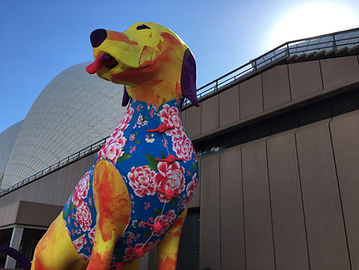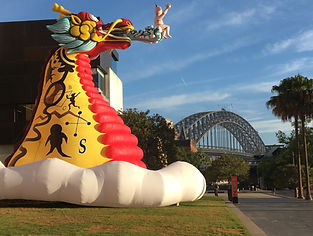Teacher and Writer
ASTRID SEELE

CHINESE NEW YEAR
Cultural empathy is not just a fuzzy emotion

Reflections in the Year of the Dog
21 February 2018
Over the last few days I have been enjoying my visits to the Chinese New Year celebrations in Sydney, and I am looking forward to attending some more. The installations would be impressive in any setting, but against the backdrop of Sydney’s famous landmarks they are nothing short of spectacular. As I was taking pictures, during the day and at night, marvelling, as I have so often done, at the beauty of Sydney harbour and smiling at the quirky ensemble of the tail-and-tongue wagging inflatable dog in front of the Opera House, overlooking the Harbour Bridge and the CBD, I thought back to the many years I spent as educator in UK boarding schools. This is where I first came across Chinese New Year, or the Spring Festival, as it is often called. Australia is so much closer to Asia than the UK, both culturally and geographically, and Sydney boasts one of the biggest Chinese New Year celebrations in the world outside Asia. When I am thinking of Chinese boarding students in Sydney, I am therefore heartened to know that they will feel well looked after during this time of the year that is so special to them.
Things are a little different in the UK, and whilst cities with a big Asian population put on big displays as well, in more remote parts of the UK there is less awareness of cultural diversity. At least that was certainly the case 20 years ago. It was back in the 1990s in Scotland when I found one of my boarding students from Hong Kong crying in her bedroom on the eve of Chinese New Year. She was deeply upset that she could not be at home with her family for the celebrations, and she explained, tearfully and emotionally, what the Lunar New Year celebrations meant to Asian families. I will be honest: until that moment I had only dimly been aware of these festivities. I knew that Asians followed the Lunar rather than the Gregorian calendar to determine the Chinese New Year, and I was aware that it involved a big and colourful show with dances and lanterns. That was probably more or less all I knew at the time.
During this conversation I learned a lot about the significance of so many of the rituals and traditions. The reunion meal that brings together families for special celebrations and to pay respect to elders and deceased ancestors. The significance of the red lanterns and the firecrackers, both designed to drive away evil spirits – the ancient man-eating beast Nian is said to have been scared of the colour red and of loud noises. The significance of giving children and young unmarried adults their red envelopes with money, symbolising prosperity and financial wellbeing. In true 21st century style the money is now often transferred digitally, with the help of WeChat red envelope, an app specifically developed for this purpose.
The focus on family, on community and togetherness, puts the significance of Chinese New Year and of any Lunar New Year celebrations in Asia at a level of significance similar to the meaning of Christmas in the western world. It was only when my Hong Kong student explained this to me that I fully understood the extent of the meaning of this festival for the many Asian students in my care and of their loneliness at this time of year. The sense of embarrassment I felt at not having asked enough questions before has informed my boarding practice and my sensitivity for other cultures and religions ever since.
The 1990s don’t seem that long ago, but it was still an era that preceded the omnipresence and omniscience of the internet. These days it is much harder to justify a lack of cultural knowledge, when information is so readily available to us all. While we have come a long way to become more informed and open-minded, there still exists a lot of bigotry, racial prejudice and cultural ignorance in this world. One look at the hateful comments on certain social media posts proves that.
During this year’s Chinese New Year celebrations, maybe we could remember that these festivities are not just a colourful spectacle, a tourist attraction and a great photo opportunity, but that they have a very special meaning for the Asian members in our communities: the young boarders in boarding schools all over the world, often sent there for their education at a very young age, unable to spend this precious time with their families, or the adults who, for whatever reason, have moved their lives elsewhere but will undoubtedly be longing for their families back home at this time of year.
I know from experience how deeply appreciative expats are when their own traditions are respected and understood in their host country and when their hosts are trying to find out more. By all means: take photos and enjoy the colours. I certainly did. Wish your Chinese friends a Happy Year of the Dog. But above all: be inquisitive and ask questions. Cultural empathy is not just a fuzzy emotion. Its extent is defined by the extent of our knowledge.
In the Year of the Dog 2018, Sydney has put on a show that displays all the animals in the Chinese Zodiac. All these Chinese lanterns are impressive by their own virtue, but I have greatly enjoyed the interplay between these animals and the Sydney landmarks: the dog poised in front of the Opera House and wistfully looking across to the Harbour Bridge or back to the CBD, the dragon with the backdrop of the Harbour Bridge, the tiger perched on the roof of a ferry wharf, the roosters turning their backs on the Opera House, the pigs in front of the Overseas Passengers Terminal, seemingly laughing at the cruise ship passengers, the arch of the rats mirroring the arch of the Harbour Bridge, the view from underneath their arch to the Opera House, or the snake menacingly posed under the thundering trains of Circular Quay Railway Station.











